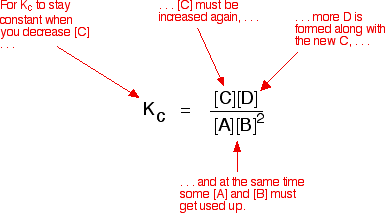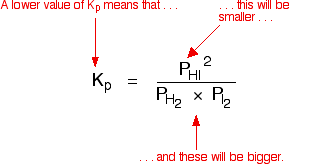Can Equilibrium Constant Be Negative
| EQUILIBRIUM CONSTANTS and LE CHATELIER'S PRINCIPLE This page looks at the human relationship between equilibrium constants and Le Chatelier'south Principle. Students oft become confused almost how it is possible for the position of equilibrium to alter equally you change the atmospheric condition of a reaction, although the equilibrium constant may remain the same. Exist warned that this page assumes a skillful understanding of Le Chatelier's Principle and how to write expressions for equilibrium constants. | |||||||
| Important:If you aren't happy nigh the basics of equilibrium, explore the equilibrium menu earlier you waste your time on this page. This folio should only be read when you are confident almost everything else to do with equilibria. | |||||||
| Changing concentrations The facts Equilibrium constants aren't changed if you lot change the concentrations of things nowadays in the equilibrium. The just thing that changes an equilibrium constant is a change of temperature. The position of equilibrium is changed if you lot change the concentration of something present in the mixture. According to Le Chatelier's Principle, the position of equilibrium moves in such a way equally to tend to undo the modify that you have made. Suppose you lot have an equilibrium established between four substances A, B, C and D. According to Le Chatelier's Principle, if you subtract the concentration of C, for example, the position of equilibrium will move to the correct to increment the concentration again. | |||||||
| Note:The reason for choosing an equation with "2B" will get clearer when I deal with the effect of force per unit area further downwardly the folio. | |||||||
| Explanation in terms of the continuance of the equilibrium abiding The equilibrium abiding, Kc for this reaction looks similar this: If you have moved the position of the equilibrium to the right (and so increased the amount of C and D), why hasn't the equilibrium constant increased? This is actually the incorrect question to enquire! Nosotros need to expect at it the other way circular. Let's presume that the equilibrium constant mustn't change if you decrease the concentration of C - because equilibrium constants are constant at constant temperature. Why does the position of equilibrium move equally information technology does? If y'all decrease the concentration of C, the top of the Grandc expression gets smaller. That would alter the value of Yardc. In order for that not to happen, the concentrations of C and D will have to increase over again, and those of A and B must decrease. That happens until a new balance is reached when the value of the equilibrium constant expression reverts to what it was before. The position of equilibrium moves - not because Le Chatelier says it must - just because of the need to proceed a constant value for the equilibrium abiding. If you subtract the concentration of C: Changing pressure This just applies to systems involving at least one gas. The facts Equilibrium constants aren't changed if you lot alter the force per unit area of the organization. The just thing that changes an equilibrium constant is a modify of temperature. The position of equilibrium may be changed if you modify the pressure. According to Le Chatelier'southward Principle, the position of equilibrium moves in such a way every bit to tend to disengage the change that you have made. That means that if you lot increment the pressure, the position of equilibrium will move in such a way as to decrease the pressure once again - if that is possible. It tin exercise this by favouring the reaction which produces the fewer molecules. If there are the aforementioned number of molecules on each side of the equation, and then a change of pressure level makes no deviation to the position of equilibrium. Explanation Where there are different numbers of molecules on each side of the equation Let'southward look at the same equilibrium we've used earlier. This one would exist affected by force per unit area because at that place are 3 molecules on the left but only 2 on the right. An increase in pressure would motility the position of equilibrium to the right. Because this is an all-gas equilibriium, it is much easier to use Kp: One time over again, it is piece of cake to suppose that, because the position of equilibrium will move to the right if you increase the pressure, Chiliadp volition increment as well. Not so! To understand why, you need to modify the Yardp expression. Remember the relationship between partial force per unit area, mole fraction and total pressure? | |||||||
| Note:If you aren't happy with this, read the beginning of the page virtually Kp before you go on. Utilize the Dorsum push button on your browser to render to this page. | |||||||
| Replacing all the partial force per unit area terms by mole fractions and total pressure gives you this: If you sort this out, most of the "P"southward abolish out - merely one is left at the bottom of the expression. Now, call back that 1000p has got to stay constant considering the temperature is unchanged. How tin that happen if yous increase P? To compensate, you would take to increment the terms on the top, 10C and xD, and decrease the terms on the lesser, xA and xB. Increasing the terms on the top means that yous have increased the mole fractions of the molecules on the right-paw side. Decreasing the terms on the bottom means that you lot accept decreased the mole fractions of the molecules on the left. That is another fashion of saying that the position of equilibrium has moved to the correct - exactly what Le Chatelier'due south Principle predicts. The position of equilibrium moves so that the value of Mp is kept constant. Where there are the same numbers of molecules on each side of the equation In this case, the position of equilibrium isn't afflicted by a modify of pressure. Why not? Let's become through the same procedure as before: Substituting mole fractions and total pressure level: . . . and cancelling out as far as possible: At that place isn't a single "P" left in the expression. Changing the pressure can't make any difference to the Kp expression. The position of equilibrium doesn't need to move to keep Grandp constant. Changing temperature The facts Equilibrium constants are changed if you change the temperature of the arrangement. Kc or Thousandp are constant at constant temperature, only they vary as the temperature changes. Look at the equilibrium involving hydrogen, iodine and hydrogen iodide: The Kp expression is: Two values for Kp are:
You can see that as the temperature increases, the value of Kp falls. | |||||||
| Note:You might possibly be wondering what the units of Gp are. This item instance was chosen because in this case, Kp doesn't accept whatsoever units. Information technology is just a number. The units for equilibrium constants vary from case to case. It is much easier to sympathize this from a volume than from a lot of maths on screen. Y'all will find this explained in my chemistry calculations book. | |||||||
| This is typical of what happens with any equilibrium where the forward reaction is exothermic. Increasing the temperature decreases the value of the equilibrium constant. Where the forward reaction is endothermic, increasing the temperature increases the value of the equilibrium constant. | |||||||
| Note:Any explanation for this needs knowledge across the scope of any UK A level (or equivalent) syllabus. | |||||||
| The position of equilibrium also changes if you change the temperature. According to Le Chatelier's Principle, the position of equilibrium moves in such a way as to tend to undo the change that you have made. If yous increment the temperature, the position of equilibrium will movement in such a way equally to reduce the temperature again. Information technology volition practice that past favouring the reaction which absorbs rut. In the equilibrium we've just looked at, that will be the back reaction considering the forward reaction is exothermic. And then, according to Le Chatelier's Principle the position of equilibrium will move to the left. Less hydrogen iodide will be formed, and the equilibrium mixture volition contain more than unreacted hydrogen and iodine. That is entirely consequent with a fall in the value of the equilibrium abiding. Adding a catalyst The facts Equilibrium constants aren't inverse if you add (or modify) a catalyst. The only affair that changes an equilibrium abiding is a alter of temperature. The position of equilibrium is non changed if y'all add (or change) a catalyst. Explanation A catalyst speeds up both the frontwards and back reactions by exactly the aforementioned corporeality. Dynamic equilibrium is established when the rates of the forrad and dorsum reactions go equal. If a catalyst speeds up both reactions to the same extent, then they will remain equal without whatever need for a shift in position of equilibrium. | |||||||
| Annotation:If you know about the Arrhenius equation, it isn't too hard to utilize it to prove that the ratio of the rate constants for the frontwards and back reactions isn't affected by calculation a catalyst. Although the activation energies for the two reactions change when you add a catalyst, they both change past the same corporeality. I'grand not going to do this bit of algebra, considering it would never be asked at this level (UK A level or equivalent). | |||||||
| Questions to test your agreement If this is the first set of questions you have done, please read the introductory page earlier you start. Y'all will need to utilize the Dorsum Push button on your browser to come back here afterwards. questions on equilibrium constants and Le Chatelier's Principle answers
To the equilibrium bill of fare . . . To the Physical Chemistry menu . . . To Master Bill of fare . . . © Jim Clark 2002 (last modified March 2021) | |||||||
Can Equilibrium Constant Be Negative,
Source: https://www.chemguide.co.uk/physical/equilibria/change.html
Posted by: banksbetation.blogspot.com













0 Response to "Can Equilibrium Constant Be Negative"
Post a Comment